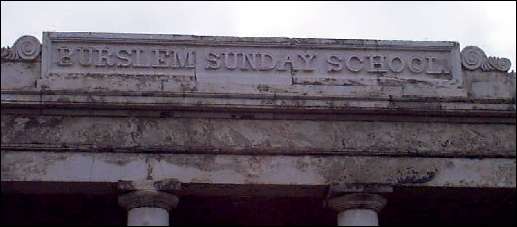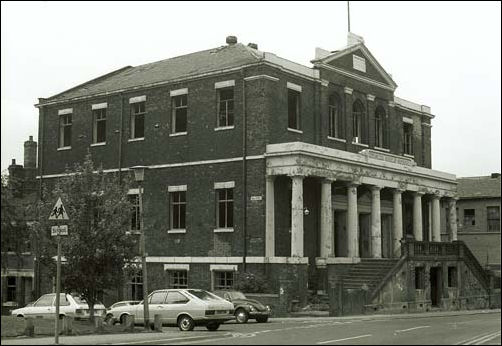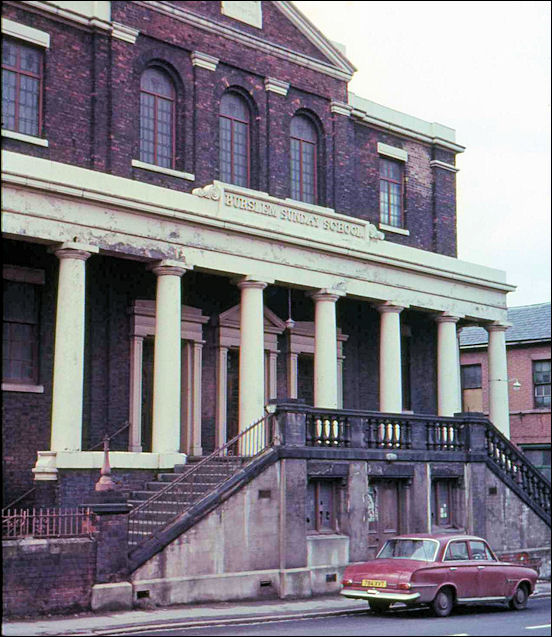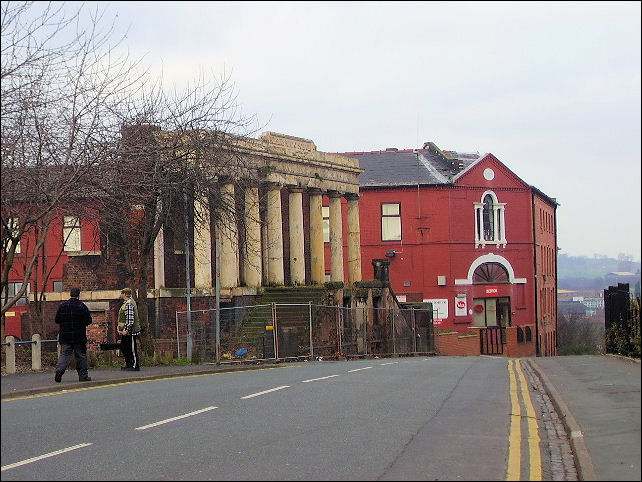|
The
origin of the Methodist New Connexion Sunday School

Burslem Sunday School
Known locally as 'Hill
Top' as it stands at the top of Westport Road.
Situated between Wade Heaths and Enoch Woods Potteries.
Forbidden
to teach writing
In 1836 a
group of Sunday School teachers were expelled from the Swan Bank Wesleyan
Methodist Chapel. The basis of expulsion was that they were teaching the
children to write as well as to read.
Sunday
School was the only education opportunity for many children in industrial
areas as at the time there was no statutory obligation to educate them and
by the age of 8 or 9 they were in full-time employment working long hours
often 6 days a week.
William
Shaw (an old potter) wrote:
'What shall I say of the benefit I got
from the Sunday School? To speak of the benefit it has been to this
nation would be a joy, and all I could say would fail to tell the
measure of its beneficence and inspiration, especially to the children
of the poor in those days. To me, very soon, it was a life within my
life........ Sunday was verily an oasis in the desert to me.'
When I was a Child William Shaw
In these schools children not only found peace
and quiet after the muck and grind of the factory; they found dedicated
men and women, willing to spend time trying to teach them all the things
of which their social class had deprived them. They offered a chance to
catch up, to make good: they offered the only chance, before compulsory
primary education, for the working-class child.
'Unfortunately, the powers above soon noticed that although thrift and
frugality were good for workmen, education was not necessarily at all
to the employer's advantage, and a distinct change of policy emerged.
It was decided that, after all, it was wicked to teach poor
children to write: a pamphlet by Robert Martin called The
Impropriety and Sinfulness of teaching children to write on the
Lord's Day shows clearly enough what kind of excuses were
thought up to cover this essentially political decision.
The teaching of writing was prohibited by the Methodist Conference:
Jabez Bunting, one of the most powerful Methodist ministers in the
first half of the nineteenth century, was determined to put an end to
what he called 'this secular art', and he succeeded. Reading was still
allowed, because after all the poor had to be able to read the Holy
Scriptures.
It's hard now to picture the pious Sunday Schools as hot-beds of
Jacobinism and dissent and radicalism, but that's how they were
regarded.
The poor, of course, were quite well aware of the reasons why they
were being deprived of their education: Shaw, the Old Potter, says, 'I
remember hearing a clergyman oppose educating the people on the
grounds that they would write nasty things on the walls'
from.. "Arnold Bennett a biography p11" -
Margaret Drabble |


Hill Top Sunday School,
Westport Road, Burslem
photo: © The Potteries Museum & Art Gallery
Staffordshire Past Track
The construction of the
this chapel was a result of a dispute between the Sunday School teachers
and trustees of the Wesleyan Chapel in Burslem. The dispute concerned a
writing ban on the Sabbath day which would severely limit many
children's education, Sundays being their only days of learning. The
clash of views came to a head in May 1836 when the teachers were locked
out of the school and at a subsequent meeting of supporters the building
of a new school was proposed.
In 1843,
it was written by Ward that:
'In 1837,
they purchased a plot of land in a prominent situation, and at a very
great expense erected a building to serve the two-fold purpose of School
rooms and a Chapel, which now forms a striking ornament to that part of
the Town. The School rooms occupy the basement storey, the Chapel the
upper storey which is galleried round very commodiously; along the whole
front and in advance of it is a portico of eight Doric columns twelve
feet in height supporting an entablature of stone on which is inscribed
in large letters, 'Burslem Sunday School'.
| In 1841 the
Superintendent of the Sunday School, Joseph Wood, was interviewed by
Samuel Scriven
who, on behalf of the government, gathered evidence about the working
conditions and education of children in the Potteries......
BURSLEM
SUNDAY-SCHOOL,
Wesleyan New Connexion, for Children of all Denominations.
No.
218.– Joseph Wood, aged 53: – I have been the superintendent of
this school 24 years. It was first established in the Wesleyan
Methodist chapel, where it was conducted for a number of years. A
dispute took place between the preachers and managers about six years
ago relative to the introduction of rules adopted by the conference,
which ended in the trustees expelling us from the premises which we
previously occupied.
This
dispute led to the erection of the present building for a school to be
conducted under the firmer system of management. At that time about
1700 children of both sexes attended. it under the tuition of 240
teachers; we have continued our efforts ever since, and now number 539
boys, with 93 teachers; and 728 girls, with 107 teachers: there is
besides this number a class of adults of 30. The building stood us in
between £3000 and £4000., out of which we have paid a considerable
sum, and stand indebted in the amount of £2093 15s. The only means we
have of defraying this is by annual collections and voluntary
contributions. Our current expenses are considerable for books, coals,
etc, which is also paid by the like means. The system of education
pursued is in part upon the Lancasterian and part upon the collective
or catechetical principle. The children meet at half-past ten and
continue till twelve, meet again at two and continue till four,
attending both before and after the religious worship of the chapel;
we admit them at five years old, and often before, and continue them
as long as they like to remain.
We have
no day-school at present, when however the debt is paid off we hope to
establish one, and support it by the seat- rents of the gallery. The
greatest number of these children have no other means of acquiring
information but by their Sunday schools, in consequence of their being
taken so early to work at the factories. I do not see much difference
in the comparative educational condition of the children of the Sunday
and day-schools, for this reason, that the time the latter devote to
it is limited. and during their infancy, and except followed up by the
former is of very little use to them. I think the potters' children
are above par – I mean those who do attend school; but there is a vast
number who are ignorant, grossly ignorant, who attend nowhere; this
results in some instances from the poverty of the parents, in others
from their extravagance, in many from their total indifference to
religious or secular education.
We have
a library attached to the school accessible to the writing and Bible
classes; the books are of history and biography; immoral works are
excluded.
(Signed) JOSIAH WOOD. |


Hill Top Sunday School c.
early 1980's
photo: Ewart Morris

The building today
This impressive building was built in 1836
on the corner of Westport Road and Hall Street.
Closed in January 1977, a fire caused widespread damage in 1983. Beyond
repair the main body was demolished in 1987 but the dramatic front portico
remains (and is a listed building)

The sad state of
the portico of the Sunday School
Feb 2008
Known locally as 'Hill Top' as it stood at
the top of Westport Road.
Situated between Wade Heaths and Enoch Woods Potteries. (Wades Hill Works
of 1814 in the background) -this is the area known as the Sytch and is the
location where Wesley preached.....
'1761, March 9th
- Preached at Burslem at half-past five, in an open place on the top of
the hill to a large and attentive congregation, though it rained almost
all the time, and the air was extremely cold....'

|
![]()
![]()
![]()
![]()
![]()
![]()